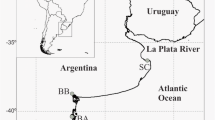Abstract
Extensive Salicornia beds along the Gulf of Kutchchh (northwest) and Tamilnadu (southeast) coasts were investigated with respect to vegetative structure and ambient environmental conditions. The width of the beds varied from approximately 5 m to 1000 m, depending upon the topography and tidal influence. The most extensive and healthy stands occurred in the regularly (20–50 tides month−1) inundated intertidal zones. The width of Salicornia beds in the Gulf of Kutchchh was greater than those along the Tamilnadu coast due to greater (0.83–7.2 m) tidal amplitude and flat topography. The sediments from beds of the Gulf of Kutchchh were rich (4.9–16.9% dry weight) in organic matter. The salt content in the sediments from Tamilnadu was relatively very low (0.08–0.1 % dry weight) compared to sediments from in the more frequently inundated regions were greater than in the poorly or less frequently inundated intertidal regions. The average total biomass varied from 0.2 to 4.5 kg (dry weight) m−2 and was mostly comprised of aboveground components. Peak biomass values of Salicornia were observed during September to February in the Gulf of Kutchchh, while along the southeast coast, they were observed during December to March. The growth of the S. brachiata seemed to be influenced primarily by the frequency of inundation, duration of atmospheric exposure at ebb tide, rainfall, and salinity and salt content of the ambient water and sediments, respectively. Average carbon and nitrogen content in the plants were estimated to be 21.7±1.9% and 0.8 ±0.17% (dry weight), respectively. The carbon content increased with increasing age of the plant, while protein content decreased. Constantly increasing anthropogenic pressures on coastal wetlands warrant immediate protection of S. brachiata and other obligate halophytes, which are either threatened/vulnerable or endangered.
Similar content being viewed by others
Literature Cited
Anon. 1931–1960. Climatological Table of Observations in India. Indian Meterological Department (IMD), Government of India Press, Nasik, India.
Anon. 1990. Coastal area classification and development regulations. Gazette Notification, part II, Section 3 (ii), No. S.C 595 (F)—Desk— 1/97, Government of India, Delhi, India.
Anon. 1992. ‘Coastal Environment,’ A Remote Sensing Application Mission. A Scientific note by Space Application Center (ISRO). Ahmedabad, funded by Ministry of Environment and Forest, Government of India. Ahmedabad, India. RSAM/SAC/COM/SN/11/92, 100.
Attia, F. M., A. A. Alsobyel, M. S. Kriadees, M. Y. Al-Saiady, and M. S. Bayoumi. 1997. Nutrient compositions and feeding value of Salicornia bigelovii torr meal in broiler diets. Animal Feed Science and Technology 65:257–263.
Biebl, R., and H. Kinzel. 1965. Blattbatu and Salzhaushait von Laguncularia (L) Gaertn. und anderer Mangrovebaume auf Puerto Rico. Osterreichische Botanische Zeitschrift 1121/2:56.
Brown, J. J., E. P. Glenn, K. M. Fitzsimmons, and S. E. Smith 1999. Halophytes for the treatment of saline aquaculture effluent. Aquaculture 175:255–268.
Folk, R. L.. 1968. Petrology of Sedimentary Rocks. Hemphill. Austin, TX, USA.
Glenn, E. P., W. O. Fames, M. C. Watson, T. L. Thompson, and R. O. Kuehl. 1991. Salicornia bigelovii Torr: an oilseed halophyte for seawater irrigation. Science 251:1065–1067.
Hooker, J. D. 1885. Flora of British India. L. Reeve and Co. Ltd. Kent, London, UK.
Hashimi, N. H., R. R. Nair, and R. M. Kidwai. 1978. Sediments of the Gulf of Kutchchh—a high energy tide dominated environment. Indian Journal of Marine Science 7:1–7.
Jagtap, T. G.. 1985. Studies on littoral flora of Andaman Islands. p. 43–50. In V. Krishnamurthy and A. G. Untawale (eds.) Marine Plants. All India Symposium on Marine Plants—Their Biology, Chemistry and Utilization. Seaweed Research Utilization Association. Madras, India.
Jagtap, T. G. 1987. Distribution of algae, seagrasses and coral communities from Lakshdweep Islands, Eastern Arabian Sea. Indian Journal of Marine Science 16:256–260.
Jagtap, T. G.. 1996. Some quantitative aspects of structural components of Seagass meadows from the southeast coast of India. Botanica Marina 39:39–45.
Jagtap, T. G. and A. G. Untawale. 1981. Ecology of seagrass beds Halophila beccarii (Ascher) in Mandovi Estuary, Goa. Indian Journal of Marine Science 16:256–260.
Jagtap, T. G., V. Chavan, and A. G. Untawale. 1993. Mangrove ecosystems of India: a need for protection. Ambio 22:252–254.
Johnson, M. J. J. 1941. Isolation and properties of pure yeast peptidase. Journal of Biological Chemistry 137:575–586.
Joshi, A. J. and E. R. R. Iyengar. 1982. Physico-chemical characterstics of soils inhibited by halophytes, Suaeda nudiflora Moq. and Salicornia brachiata Roxb. In Gujarat Indian Journal of Marine Science 11:199–200.
Pennings, S. C. and R. M. Callaway. 1992. Salt marsh plant zonation: The relative importance of competition and physical factors. Ecology 73:681–690.
Prain, D. 1994. Flora of the Sundribans. Allide Book Centre. Deharadun, India.
Rao, T. A., S. Molur, and S. Walker. 1998. Mangroves of India. Report Summary. Zoo’s Print 14:1–50.
Rey, J. R., J. Shaffer, R. Crossman, and D. Tremain. 1990. Above-ground primary production in impounded, ditched, and natural Batis-Salicornia marshes along the Indian River Lagoon, Florida, USA. Wetlands 10:151–171.
Rowcliffe, J. M., A. R. Watkinson, and W. J. Sutherland 1998. Aggregative responses of brent geese on salt marsh and their impact on plant community dynamics. Oecologia 114:417–426.
Strickland, J. D. H. and T. R. Parson. 1972. Determination of salinity by titration. p. 11–19. In J. C. Stevenson (ed.) A Practical Handbook on Seawater Analysis. Fisheries Research Board of Canada. Ottawa, ON, Canada.
Ungar, I. A. 1987. Population characteristics, growth, and survival of the halophyte Salicornia europaea. Ecology 68:569–575.
U.S. Department of Agriculture. 1987. Agricultural Statistics. U.S. Government Printing Office, Washington, DC, USA.
Author information
Authors and Affiliations
Rights and permissions
About this article
Cite this article
Jagtap, T.G., Bhosale, S.H. & Nagle, V.L. Ecological observations on major Salicornia beds from highly saline coastal wetlands of India. Wetlands 22, 443–450 (2002). https://doi.org/10.1672/0277-5212(2002)022[0443:EOOMSB]2.0.CO;2
Received:
Revised:
Accepted:
Issue Date:
DOI: https://doi.org/10.1672/0277-5212(2002)022[0443:EOOMSB]2.0.CO;2




